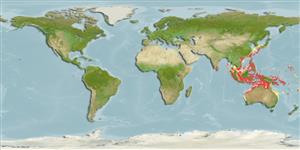>
Gobiiformes (Gobies) >
Gobiidae (Gobies) > Gobiinae
Etymology: Eviota: No etymology given, suggested by Christopher Scharpt: from Latin 'eu' for 'true' and 'iota' for anything very small, in combination 'truly very small' referring to it as being the smallest vertebrate at the time it has benn described by Jenkins (thus, making the suggestion by Scharpt plausible..
Environment: milieu / climate zone / depth range / distribution range
Écologie
marin benthopélagique; profondeur 0 - 60 m (Ref. 85778). Tropical
Eastern Indian Ocean to Western Pacific: Ryukyu Islands, Brunei, Indonesia (N. Sulawesi & West Papua), Papua New Guinea, Philippines, Palau, Western Australia, and Sri Lanka.
Taille / Poids / Âge
Maturity: Lm ? range ? - ? cm
Max length : 2.4 cm SL mâle / non sexé; (Ref. 81713)
Description synthétique
Morphologie | Morphométrie
Épines dorsales (Total): 6 - 7; Rayons mous dorsaux (Total): 8-9; Épines anales 1; Rayons mous anaux: 8 - 9. This species have the complete cephalic sensory-canal pore configuration, pores B', C (unpaired), D (unpaired), E, F, H', N' and O'. It differs from the other species of this subgroup in having the following set of characters: usually 9 dorsal-fin and 8 anal-fin segmented rays; well-developed membranes between pelvic-fin segmented rays; densely pigmented on edge of scale pockets, forming dusky reticulations on body; middle of first dorsal fin with a narrow arc-shaped, diagonal pale band (subtranslucent in preserved specimen); 5-7 diagonal bright-blue to pale-blue bars (translucent and sometimes quite indistinct in preserved specimens) on second dorsal and anal fins in each; 2 ovoid dusky spots on dorsal and ventral parts of pectoral-fin base; absence of an enlarged, distinct subcutaneous dusky spot on mid-lateral caudal peduncle; caudal fin with no conspicuous dusky markings (Ref. 81713).
Inhabits coral reefs (Ref 90102).
Life cycle and mating behavior
Maturité | Reproduction | Frai | Œufs | Fécondité | Larves
Shibukawa, K. and T. Suzuki, 2005. Two new species of the gobiid fish genus Eviota (Teleostei, Perciformes, Gobioidei) from the Western Pacific. Bull. Natl. Sci. Mus. Ser A 31(2):65-76. (Ref. 81713)
Statut dans la liste rouge de l'IUCN (Ref. 130435)
Menace pour l'homme
Harmless
Utilisations par l'homme
Plus d'informations
PaysZones FAOÉcosystèmesOccurrencesIntroductionsStocksÉcologieRégime alimentaireÉléments du régime alimentaireConsommation alimentaireRation
Noms communsSynonymesMétabolismePrédateursÉcotoxicologieReproductionMaturitéFraiRassemblement de ponteFéconditéŒufsDéveloppement de l'œuf
Taille/ÂgeCroissanceLongueur-poidsLongueur-longueurFréquences de longueursMorphométrieMorphologieLarvesDynamique des populations larvairesRecrutementAbondanceBRUVS
RéférencesAquacultureProfil d'aquacultureSouchesGénétiqueElectrophoresesHéritabilitéPathologiesTraitementNutrientsMass conversion
CollaborateursImagesStamps, Coins Misc.SonsCiguateraVitesseType de nageSurface branchialeOtolithesCerveauxVision
Outils
Articles particuliers
Télécharger en XML
Sources Internet
Estimates based on models
Preferred temperature (Ref.
123201): 25.4 - 29, mean 28.1 °C (based on 538 cells).
Phylogenetic diversity index (Ref.
82804): PD
50 = 0.5000 [Uniqueness, from 0.5 = low to 2.0 = high].
Bayesian length-weight: a=0.00708 (0.00333 - 0.01504), b=3.09 (2.92 - 3.26), in cm total length, based on LWR estimates for this (Sub)family-body shape (Ref.
93245).
Niveau trophique (Ref.
69278): 3.1 ±0.3 se; based on size and trophs of closest relatives
Fishing Vulnerability (Ref.
59153): Low vulnerability (10 of 100).
